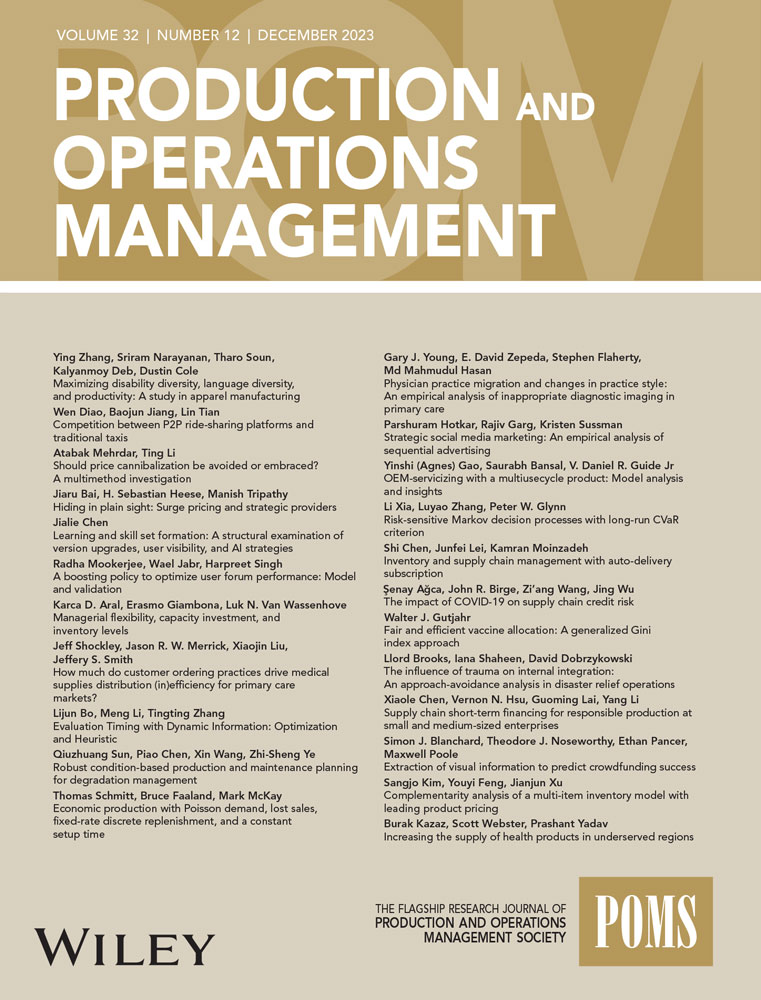冲突下架和重新上架对零售商店剩余产品的影响:跨产品类别的销售收益和对附近商店的溢出效应
IF 5.1
3区 管理学
Q1 ENGINEERING, MANUFACTURING
引用次数: 1
摘要
零售商与制造商之间的纠纷往往导致零售商将制造商的产品下架,从而极大地改变了零售市场的竞争格局。当竞争对手的产品暂时下架时,留在零售货架上的产品预计会因为替代而获得销售。然而,目前尚不清楚剩余产品的销售收益可以预期多少,竞争产品重新上市后的销售收益持续多久,不同产品类别的销售收益是否不同,以及销售收益是否会从退市零售商溢出到附近的零售商。在本研究中,我们利用了一个自然实验,该实验是由一家零售连锁店和一家饮料制造商之间的纠纷引起的,该纠纷导致该制造商(被退市的制造商)在该零售商的所有美国商店中将所有产品下架了4周。我们专注于与退市制造商直接竞争的制造商(重点制造商),并量化该重点制造商在退市期间和重新上市事件后的销售收益。有趣的是,在近乎双头垄断的市场中,重点制造商在退市期间仅增长了12.2%的销售额。在纠纷解决和竞争恢复后,焦点制造商的销售波动了大约2个月,然后恢复到退市前的水平。此外,我们发现,在退市期间,销售收益会溢出到附近的商店,主要是小型零售商店,而不是大型商店。此外,在退市和附近的商店中,我们发现焦点制造商的含糖、含咖啡因和明星产品在活动期间销量增加,而其他产品则没有。我们使用机器学习非参数方法检查结果的稳健性,以及其他几种替代方法,以测量平均治疗效果。了解这些异质性效应的大小和持续时间可以帮助制造商和零售商更好地应对市场竞争的变化,并评估其退市决策。本文章由计算机程序翻译,如有差异,请以英文原文为准。
Impact of conflict delisting and relisting on remaining products in retail stores: Sales gains across products categories and spillovers to nearby stores
Abstract Disputes between retailers and manufacturers often result in the retailer delisting the manufacturer's products, which dramatically alters competition in the retail market. When rival products are temporarily delisted, the products remaining on retail shelves are expected to gain sales due to substitution. However, it is unclear how much sales gain of remaining products can be expected, how long the sales gain persists after the rival products are relisted, whether the sales gain varies in different product categories, and whether the sales gain spills over from the delisting retailer to nearby retailers. In this research, we exploit a natural experiment enabled by a dispute between a retail chain and a beverage manufacturer that resulted in a 4‐week delisting of all products by the manufacturer (the delisted manufacturer) across all of the retailer's U.S. stores. We focus on a manufacturer (the focal manufacturer) that directly competes with the delisted manufacturer and quantify the sales gain for this focal manufacturer during the delisting and after the relisting event. Interestingly, in a near‐duopoly market, the focal manufacturer only gained 12.2% of sales during the delisting. After the dispute was settled and competition restored, the focal manufacturer's sales fluctuated for about 2 months before returning to the pre‐delisting level. Additionally, we find a spillover in sales gain to nearby stores during the delisting, which was mainly to small‐box retail stores rather than big‐box stores. Moreover, at both delisting and nearby stores, we find the focal manufacturer's sugar‐sweetened, caffeinated, and star products gained sales during the event while other products did not. We check the robustness of our results with a machine learning nonparametric method, among a few other alternative methods, to measure the average treatment effects. Understanding the size and duration of these heterogeneous effects can help manufacturers and retailers better respond to changes in market competition and evaluate their delisting decisions.
求助全文
通过发布文献求助,成功后即可免费获取论文全文。
去求助
来源期刊

Production and Operations Management
管理科学-工程:制造
CiteScore
7.50
自引率
16.00%
发文量
278
审稿时长
24 months
期刊介绍:
The mission of Production and Operations Management is to serve as the flagship research journal in operations management in manufacturing and services. The journal publishes scientific research into the problems, interest, and concerns of managers who manage product and process design, operations, and supply chains. It covers all topics in product and process design, operations, and supply chain management and welcomes papers using any research paradigm.
 求助内容:
求助内容: 应助结果提醒方式:
应助结果提醒方式:


